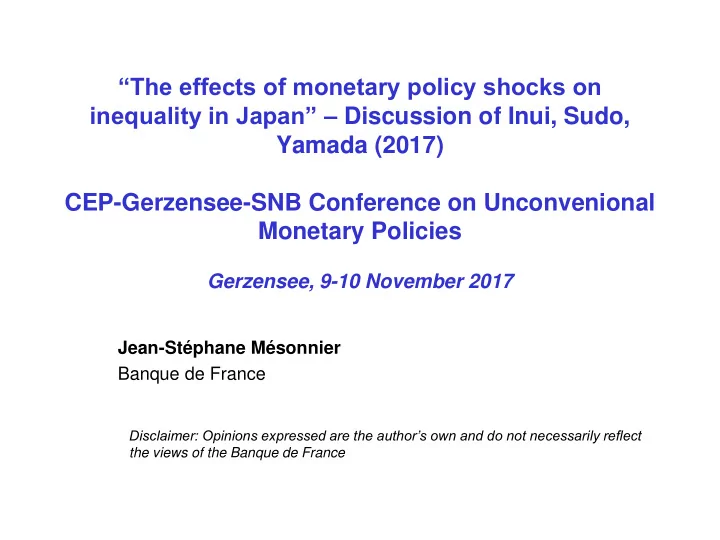

“The effects of monetary policy shocks on inequality in Japan” – Discussion of Inui, Sudo, Yamada (2017) CEP-Gerzensee-SNB Conference on Unconvenional Monetary Policies Gerzensee, 9-10 November 2017 Jean-Stéphane Mésonnier Banque de France Disclaimer: Opinions expressed are the author’s own and do not necessarily reflect the views of the Banque de France
This paper • Empirical assessment of impact of MP shocks on income/consumption inequality in Japan, 1981-2008 – Genuine aggregate inequality measures from income survey, LLP- FAVAR approach with Cholesky, Shadow rate when ZLB – Exp. MP increases income (earnings), but not consumption, inequality. Holds over ‘81 - ’99, not after 2000. Role of heterogenous MPC in low transmission from Y to C. • Stylized GE model with sector-specific + mobile labour: – illustrates potential role of structural change in labour market (↑ flexibility/turnover) • Additional exercise using SHF data: no evidence of active asset price/inflation channels affecting wealth inequality. 2 Mésonnier - Discussion of Inui, Sudo, Yamada - Nov. 2017
Monetary policy and inequality: what do we expect? • Expansionary MP generally implies: – Lower short (and long = TSH) interest rates – Higher asset prices – Higher inflation – and, on the way, stronger activity/employment (+hysteresis) • UMP vs MP? – More emphasis on lowering long term rates (FG): TSH + premia – Direct asset purchases: more distorsions 3 Mésonnier - Discussion of Inui, Sudo, Yamada - Nov. 2017
Expansionary MP and inequality: what do we expect? • Which inequality look at: wealth / income / consumption? • Job creation channel: – (Strong) ↓ income inequality (e.g., Ampudia, Pavlickova, Slacalek, Vogel, JPM 2016) • Inflation [“saving redistribution”] channel: – ↓ wealth inequality if poor net Euro area inequality borrowers (e.g., Adam & Zhu, indicators. Source: HFCS JEEA 2015) Mésonnier - Discussion of Inui, Sudo, Yamada - Nov. 2017 4
Expansionary MP and inequality: what do we expect? • Asset prices [“portfolio”] channel: – ↑ wealth inequality (due to skewed stock holdings). See Adam & Tzamourani (EER, 2016) for EA, Saiki & Frost (2014) for Japan post 2008 – From wealth to consumption inequality? Different MPC across wealth distribution (Arrondel, Lamarche, Savignac, 2016) • Income composition (K vs L) channel: – ↑ income inequality if boosts K income more than L income (see Coibion et al., 2012) • Wage heterogeneity channel: main focus of this paper – ↓ earnings inequality (Mumtaz & Theophilopoulou, 2016, for UK). 5 Mésonnier - Discussion of Inui, Sudo, Yamada - Nov. 2017
Comment 1: data • Very volatile measures of (disposable) income inequality – Figures: Gini, Japan from ISY vs Gini, developed economies (Chartbook of economic inequality) • Why? Should we care? Mésonnier - Discussion of Inui, Sudo, Yamada - Nov. 2017 6
Comment 2: focus of paper • Use of shadow rate in this linear setup over 3 decades => UMP assumed to have similar channels/effects as CMP – Vindicated? – MS-VAR suggests: no • Other major issue: impact on inequality of switching on/off UMP (or not, or untimely…) – Japan: great “lab” for this! IRFs from MS-VAR, Hayashi & Koeda (2017) Mésonnier - Discussion of Inui, Sudo, Yamada - Nov. 2017 7
Comment 3: empirical approach and identification • Two-step methodology: – FAVAR (~ BBE, 2005): Macro factors’ ( includ. MP rate) dynamics and MP shock identification – LLP: Macro factors (including MP) → Inequality forecasts • Why not simply a dynamic factor model (FAVAR) ? – Motivation in Aikman et al. (2016) is different (factors supplement forecasts aimed at solving endogeneity pb) – Measurement equation: X=L*F+B*R+u with inequality indicators in X ; Transition equation: FAVAR. – Alternatively: Bayesian VAR including inequality measures 8 Mésonnier - Discussion of Inui, Sudo, Yamada - Nov. 2017
Comment 3: empirical approach and identification (2) • Factor extraction and shock identification within FAVAR using Cholesky (MPR ordered last, after PC factors extracted from X) – X includes financial asset prices: difficult to assume delayed reaction to MP rate shock… – Besides, this may be inconsistent with use of shadow rate (inferred, outside of model, from shape of contemporaneous YC using an affine TS model) – Force Rt to be a factor (Boivin, Gianonni, 2009) or extract Ft from slow-moving macro variables as in BBE (2005) • Factors are “generated” regressors: use bootstrap for inference and confidence intervals 9 Mésonnier - Discussion of Inui, Sudo, Yamada - Nov. 2017
Other comments • Right combination of theory and empirics still to be found: – Model meant to stress role of market flexibility. Rather illustrative so far, some ad-hocities (adjustment costs eg) – Either put it upfront and enrich it (core focus), or drop it? • Figure 7 suggests job creation channel kills main result on earnings inequality. What impact on consumption inequality? Does it drop? • Assessment of impact on wealth inequality: why look at wealth changes by income quintiles instead of wealth quintiles? Impressive amount of work. Very stimulating paper. Maybe needs some streamlining. Good luck! 10 Mésonnier - Discussion of Inui, Sudo, Yamada - Nov. 2017
Recommend
More recommend